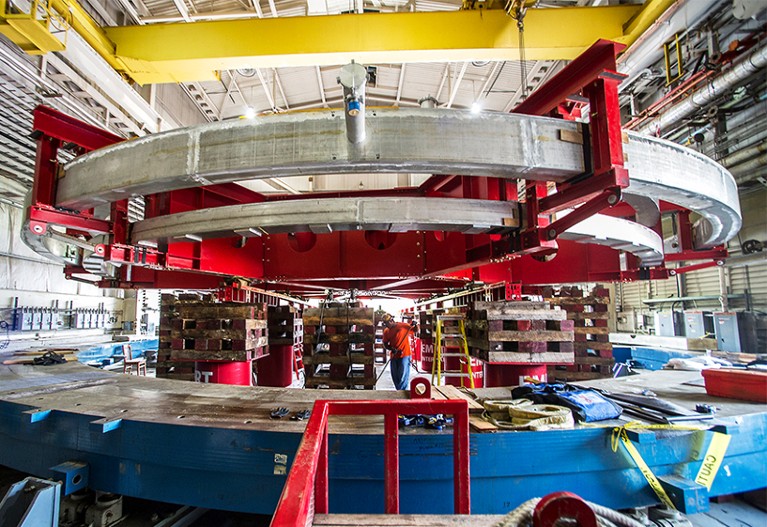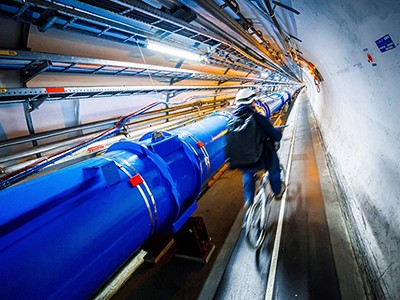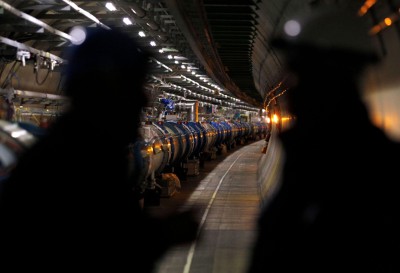
The Muon g – 2 experiment at Fermilab, near Batavia, Illinois, is designed to study the properties of muons. Researchers now want to smash muons at high energies to produce other particles.Credit: Brookhaven National Laboratory/SPL
Last month, a group of researchers in the United States presented a rousing vision for the future of high-energy particle physics. The recommendations from the Particle Physics Project Prioritization Panel (P5) came in response to a request from funding agencies to set out priorities for building new facilities. One stood out: to push for the development of an entirely different type of particle collider, called a muon collider. It’s a bold suggestion that could shape the face of high-energy physics for decades to come. It is also a rare opportunity to continue the global unity that characterizes much of the particle-physics community. Laboratories across the rest of the world, but in particular at CERN, Europe’s particle-physics laboratory outside Geneva, Switzerland, should contribute to it.
Since the discovery of the atomic nucleus in 1911, studying the collisions of atoms or particles has been the chief method for understanding the detailed nature of subatomic matter and the forces that govern its behaviour. In modern experiments, collisions typically happen between highly focused, accelerated beams of electrons or protons travelling in opposite directions. Researchers at CERN’s Large Hadron Collider (LHC), the world’s highest-energy accelerator, discovered the Higgs boson particle in 2012 by smashing protons together and seeing what massive particles these highly energetic collisions produced.
A muon collider would use beams of muons, particles similar to electrons but around 200 times heavier. It would enable tests similar to those run in proton-beam experiments, but releasing ten times as much energy, and with lower energy consumption — potentially making it much cheaper. Such a machine could also explore interactions that have been difficult to study with other colliders, allowing researchers to test the established theory of elementary particles, called the standard model, in new ways.

Big Bang observatory tops wish list for big US physics projects
Getting there will be neither easy nor quick. For a start, researchers do not yet know for sure that it can be done. Muons are routinely created in high-energy-physics labs, but they are unstable and quickly decay into other particles. The technology to accelerate muons into tightly focused beams before they disappear is still in its infancy.
To make it happen, the P5 authors call for a US “muon shot” — language intended to evoke images of the 1960s and 70s Apollo Moon programme that landed men on the Moon. The aim would be first to develop the technology to the point of proof of principle, and ultimately to build a full-size muon collider on US soil.
This, the panel says, would restore US leadership in physics of the highest energies, which, since the 1993 cancellation of the country’s own huge proton collider, the Superconducting Super Collider, has mostly been ceded to Europe, CERN and the LHC .
Looking to a future beyond the LHC, CERN completed a future strategy study in 2020 that also called for muon-collider research and development. The institution subsequently allocated seed funds, with money from the European Union and some individual member countries, to study the plan’s feasibility, setting up the International Muon Collider Collaboration.
The group does not have enough money to get started, however. Indeed, CERN’s preferred vision is to build not a muon collider, but a Future Circular Collider (FCC) instead, at CERN itself. This project, which comes with an anticipated price tag of more than US$30 billion, would involve constructing an accelerator tunnel more than 90 kilometres in circumference, three times longer than that hosting the LHC. This would initially host an electron–antielectron linear collider, to study the detailed properties of the Higgs boson, and would later be replaced with a proton collider capable of producing energies seven times higher than the LHC. CERN’s rationale for favouring such an approach (other than for Europe to retain its prominent position in the field) includes the fact that alternative technologies — such as muon colliders and the acceleration of protons using waves of plasma — are as yet unproven.

Particle physicists want to build the world’s first muon collider
But the proton-smashing stage of CERN’s FCC project would also necessitate pushing several technologies — in particular, superconducting magnets — substantially beyond their current state. Even assuming that it gets funded and is eventually built, the FCC’s proton collider probably would not start up until the 2070s; hence the researchers’ proposal for an intermediate electron collider. CERN physicists think that this work will keep them busy studying the Higgs, and keep the lab relevant in the intervening decades.
Even some of the physicists backing the FCC acknowledge that there is not yet a strong scientific case for building the collider. So far, experiments have failed to find any substantial hints of physical phenomena beyond those described in the standard model occuring at the higher energies to be generated by the FCC. And there could be cheaper and simpler ways to study the Higgs, such as with a linear electron–antielectron collider. As well as being cheaper than a circular ‘Higgs factory’, a linear collider would also enable more-precise studies of the Higgs boson, some physicists say.
Given the amount of public money involved, it is not possible to completely take geopolitics out of the equation. But the rationale for such projects does not need to be about the leadership of particular countries or regions. A more effective way to argue for a muon collider is for physicists to see this as a genuinely global endeavour. It offers an opportunity for particle physicists in the United States, at CERN and elsewhere to put their heads together and establish whether a muon collider is feasible and, if so, at what cost, and who can contribute expertise and facilities. If it works out, particle physicists all over the world might gain an exciting — and potentially more affordable — way of probing nature.
